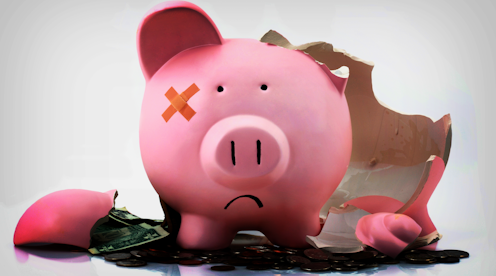
U.S. regulators’ swift reaction to the collapse of Silicon Valley Bank and two other lenders partially restored calm to markets, but concerns remain over the stability of the global financial system.
The government is racing to orchestrate a US$30 billion rescue of First Republic Bank by the nation’s largest financial institutions after the California lender’s shares continued tanking. Meanwhile in Europe, Credit Suisse’s own financial woes deepened, prompting the Swiss government to offer a lifeline. While Credit Suisse’s issues are unrelated to those of the failed U.S. banks, they further exposed deep anxiety in global financial markets.
To better understand what U.S. regulators did, the impact of their decisions and what problems remain, The Conversation turned to two finance scholars, Brian Blank of Mississippi State and Brandy Hadley of Appalachian State.
What did US regulators do?
The program introduced by the Federal Deposit Insurance Corp., the Department of the Treasury and the Federal Reserve on March 12, 2023, essentially amounts to life insurance for U.S. banks.
The biggest concern from the sudden collapse of Silicon Valley Bank on March 10, as well as Signature Bank two days later, was the tens of billions of dollars in deposits that would otherwise go uninsured. While the FDIC insures deposits up to $250,000, anything above that is at risk of loss in the event of a bank failure.
So the FDIC agreed to provide a backstop for all SVB and Signature depositors no matter how much they had deposited. And the Fed created a new lending facility to protect other small- to medium-size banks from the same issues that caused bank runs at SVB and Signature.
Notably, this protection for depositors does not extend to management, lenders or investors, including many institutional investors, pensions and large index funds. In addition, the program will be funded by an FDIC fund that comes from a tax on member banks. Taxpayer dollars aren’t at stake, Congress approval wasn’t required and, most importantly, only customers’ claims are protected. This is why the Biden administration insists this is not a bailout – even though some critics call it that.
Nonetheless, the government did intervene to stop the fallout from failing banks, even if done differently than in the past.

Why did the government act so quickly?
When the bank run on SVB’s deposits began on March 8, the lender initially sought to find a buyer. When that failed, regulators stepped in quickly to limit the risk to the financial system.
This was particularly important given that banks rely heavily on trust, and a loss of depositor faith in other mid-size banks could be extremely harmful.
But besides posing a systemic financial risk as the 16th-largest U.S. lender, the failure of SVB also threatened the health of the tech sector.
Close to half of U.S. startups backed by venture capital firms, including tens of thousands of technology and health care companies, were customers at SVB. The bank’s failure would have made it hard for many of them to pay their workers or take out loans that keep businesses running.
What are the problems of this approach?
One concern is something economists call moral hazard.
U.S. regulators were basically doing what governments have done to prevent banking crises since at least the 19th century: provide liquidity. That is, according to the academic theory established by Economist magazine founder Walter Bagehot in 1873, central banks should lend freely to lenders during a financial crisis to prevent a panic and restore confidence in the system.
But doing this could create a moral hazard by potentially encouraging risky behavior by banks, which may come to believe they will always be bailed out. This dilemma highlights the challenge of balancing the need for financial stability with the desire to avoid creating perverse incentives.
With the SVB rescue, regulators likely hope to avoid this by focusing protection efforts on depositors – not equity or debt investors.
Another problem is that the rescue treats the symptoms more than the root causes.
The source of SVB’s downfall was that it invested a significant chunk of its assets in Treasury securities that lost value as the Fed hiked rates in 2022. SVB sold $21 billion worth of these bonds at a loss of $1.8 billion in order to cover customer deposit withdrawals. This then prompted a stampede of clients to yank their mostly uninsured deposits.
But despite the depositor protection offered by the new program, many more banks still face asset-liability mismatches – that is, short-term deposits being invested in longer-term securities – that will not go away as a result of the program. Banks reported $620 billion of these unrealized losses as of December 2022.
Some other banks – such as Signature and Silvergate Capital, which also recently failed – are similar to SVB, with concentrated business in risky sectors like venture capital, technology or cryptocurrencies.
How big of a concern is the root of the problem?
The good news is that few banks are likely to have the same combination of unrealized losses, concentrated deposits and default risk that are likely to result in withdrawals as fast as what happened at SVB and Signature.
Critically, large and mid-size banks are sufficiently regulated, diversified, hedged and capitalized to prevent similar problems, especially given the very different balance sheet compositions and asset liability management strategies.
But the risks are big, as the Fed’s aggressive campaign to raise interest rates could potentially make things worse. Inflation remains elevated, which would normally lead the U.S. central bank to continue to drive up rates. The nascent concern about stabilizing the financial sector at the same time as taming inflation means the Fed has its work cut out for it.
So is the financial system safe?
Unfortunately, not yet.
While the crisis has been averted for now by limiting the risk of another bank run, the financial system – as well as the modestly strong U.S. economy – is showing cracks and fragility.
The recent troubles at Credit Suisse are a stark reminder of how quickly things can spiral out of control. Credit Suisse shares have been under pressure for several years because of its own unique problems, including scandals and a closely knit customer base that makes it more vulnerable to contagion.
But now the recent U.S. bank failures are causing broader panic among banks globally, and this is hitting shares of Credit Suisse hard, prompting the Swiss National Bank – Switzerland’s equivalent of the Fed – to promise to provide liquidity if necessary. This offers some relief but signals just how easily things can spiral out of control.
There’s no reason to think that the financial system is in serious trouble – for now – but the risks of more jitters have increased, putting more pressure on central banks, including the Fed, to roll back their inflation-fighting plans. Of course, doing so can unleash other risks – such as prices once again spiraling out of control.
All told, it’s a challenging balancing act, requiring careful precision and swift action to avoid a painful fall.
Les auteurs ne travaillent pas, ne conseillent pas, ne possèdent pas de parts, ne reçoivent pas de fonds d'une organisation qui pourrait tirer profit de cet article, et n'ont déclaré aucune autre affiliation que leur organisme de recherche.
This article was originally published on The Conversation. Read the original article.







